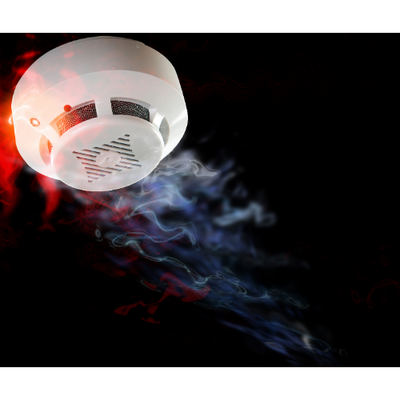- 1-905-452-8193
- Contact Us
- Member Login
- Get Listed Today
- 220,911 members

Smoke and carbon monoxide (CO) alarms going bad and necessitating replacements is a situation that every homeowner will likely face multiple times in their life.
How Smoke & CO Alarms Operate and Their Necessity
Smoke and CO alarms serve as practical devices strategically positioned within residences to alert occupants to escalating fire risks or the accumulation of hazardous carbon monoxide (CO) gas.
Typically, these units are placed near sleeping areas, as incidents involving fire and CO often become more critical due to the delayed response of sleeping individuals compared to those who are awake and alert.
To address this concern, the Maryland Smoke Alarm Law was enacted in 2013, mandating that homes with battery-powered smoke alarms must upgrade to newer, tamper-resistant models by January 1, 2018. Prior to this law, Maryland property owners had the flexibility to select any type of alarm, leading to variations in lifespan due to battery usage.
Under the current law, a 10-year sealed and tamper-resistant unit must be installed, preventing battery removal without replacing the entire unit.
This legislation was prompted by numerous unfortunate incidents where homes, property, and lives were lost due to homeowners disconnecting alarms or neglecting to replace dead batteries. Although these outcomes were unintentional, they could have been entirely preventable through proper maintenance. In response, Maryland legislators intervened to regulate this matter. Given that having a functional alarm in the home reduces the risk of death by half, it's evident why this initiative became a crucial undertaking for the State.
Placement Guidelines for Alarms in Your Home
Homeowners should install alarms in the following locations:
One (1) in each bedroom
One (1) for each hallway leading to bedrooms
One (1) on every floor or level of the home
Not within 3 feet of a return duct, bathroom (due to humidity), or attic entry (due to dust)
You might be wondering, "Don't I need an alarm in the kitchen?" In fact, we recommend against installing a smoke alarm in the kitchen, as it can often be triggered by cooking smoke and exhaust rather than a genuine threat. If a fire breaks out in the kitchen while you're not present (ideally, you should always be in the kitchen while cooking), alarms on the same floor or in the hallways leading to bedrooms will alert you to the danger.
Regarding CO alarms, surprisingly, Maryland is one of 32 states that has imposed legal requirements on property owners to install CO alarms. All new construction projects, specific remodels/renovations, and properties with fossil fuels (such as oil heating systems or garages with storage) must have a CO alarm.
If you fall into the category of homeowners needing both smoke and CO alarms, it's advisable to opt for combination alarms.
Types of Smoke & CO Alarms
While there isn't an extensive array of alarm types on the market, the distinctions between them warrant consideration for their suitability in various locations within your home.
Ionization Smoke Alarm - Ionization smoke alarms are widely recognized by Americans, being the most prevalent option. These alarms excel at detecting rapidly spreading fires, which can be the most destructive and unpredictable.
Such fires often ignite and escalate quickly, as seen in cases of electrical shorts, appliance malfunctions, or external factors. When a fire emits smoke, the ionization chambers within the alarm are affected, altering the current and triggering the alarm. Due to the possibility of false alarms, these alarms aren't recommended for installation in kitchens.
Photoelectric Smoke Alarm - Less familiar but equally important are photoelectric smoke alarms, designed to alert homeowners of slow-burning or smoldering fires. While ionization alarms are commonly used throughout homes, some homeowners choose to place photoelectric alarms in their bedrooms.
This approach is especially relevant if you smoke in bed or use a space heater while sleeping. These alarms are less prone to triggering from minimal smoke but will activate when thicker smoke is detected. They rely on a light-sensitive sensor that remains unaffected during normal conditions. However, when smoke particles enter the unit during a fire, they disturb the light within the sensor, prompting the alarm to sound.
Dual-Sensing Photoelectric & Ionization Smoke Alarms - Given the diverse nature of fires, it's challenging to determine the ideal alarm for a specific environment. That's why we often suggest the installation of dual smoke alarms that combine both photoelectric and ionization technologies. In theory, one type of fire triggers one technology, while the other type of fire triggers the alternate technology.
Carbon Monoxide (CO) Alarms - Unlike smoke alarms, carbon monoxide detectors are subject to less stringent regulations. However, this is changing rapidly, as evidenced by the legal requirements mentioned earlier. Faulty furnaces, heaters, wood-burning stoves, gasoline-powered tools, propane equipment, and vehicle exhaust can all contribute to CO poisoning.
Although not always fatal, CO poisoning can prove fatal for those who fail to notice the initial symptoms, often occurring during sleep. CO alarms operate similarly to smoke alarms but monitor carbon monoxide levels in the air. When concentrations surpass a certain threshold, the alarm will activate.
Combination Smoke + CO Alarms - While these units might be slightly pricier, the convenience of having combined alarms in your home outweighs the cost. This eliminates the need for installing multiple alarms, often requiring hardwiring in certain areas. If you're replacing existing units and can afford the upgrade to combination alarms, rest assured that they offer enhanced convenience and comprehensive protection.
|
|
